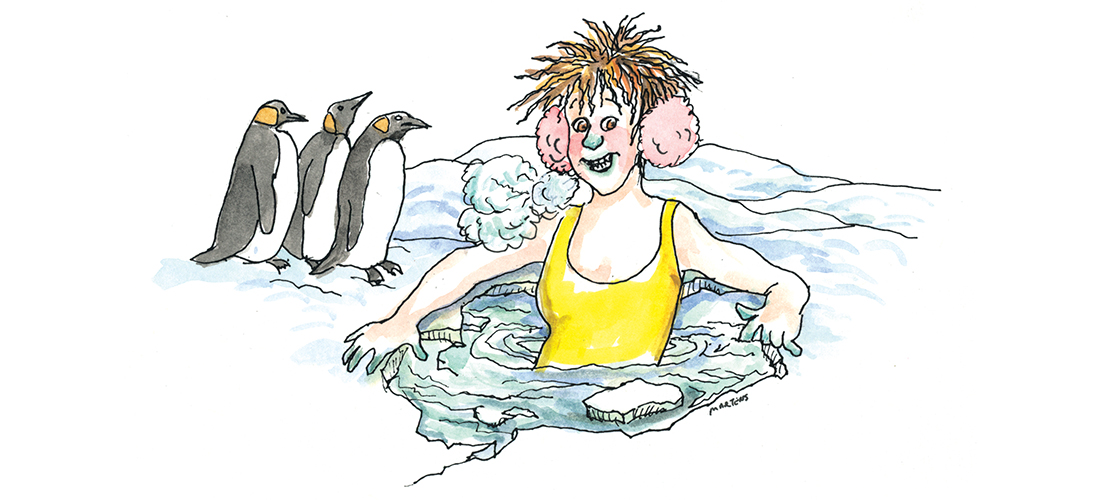
Brrrrrrrrrr!
Freezing? Get used to it.
By Kate Smith
“Did you lose a bet?”
It was a little old lady out walking her dog. I’m in my bikini, wringing water out of my hair on the edge of a Whispering Pines lake. High on endorphins, I just laugh. “It’s good for me,” I say.
I’m not naturally hot-blooded. I don’t have the selkie genes — named for the seal folk of Norse mythology — we hear about in people who survive hours in glacial water. And I don’t have a high concentration of that metabolic unicorn, brown adipose tissue. In fact, I have a 97-degree average body temperature, am borderline anemic, and I hate the cold. But I’m trying to change that.
It started back in September. On gut instinct, I bought a used 9-foot longboard and taught myself how to surf. It was meditative medicine and nothing has kept me out of the water since. I don’t mind the rashes, skinned legs from wipeouts in broken seashells, sinuses raw with salt water, or bruises on my ribs. I’m not afraid of sharks, even after seeing one a few feet away on my second day in the water, and I’m not fazed by jellyfish stings or colliding with fishing lines. But as soon as winter hit, the cold has given me a run for my money.
I have Raynaud’s, an autoimmune condition that constricts the tiny blood vessels to my fingers and toes, making them go white and numb from cold exposure as insignificant as the produce aisle in the grocery store. Despite a full wetsuit with hood, gloves and boots, they still go numb, and it doesn’t take long before my dexterity nosedives, and then so do I. A lot.
Add to that the darkness of winter, and despite my best intentions, I’ve found myself huddled in my house for entire weekends, fatigued by the gloom and too cold to surf, the thing that helps the most. I hate the cold. But, really, I’m trying to change that.
I heard about this guy named Wim Hof. He climbed Mount Kilimanjaro in shorts and ran a half marathon above the Arctic Circle barefoot. I figured if this normal dude can train his body to thrive in the Arctic, I can certainly figure it out here in the South for the sake of getting back on my surfboard.
According to Wim, the process of cold adaptation is pretty simple. Do it, safely, until it doesn’t suck so much. The first time I waded into a cold lake, the water felt like razor blades. I dipped under, and came up with my heart pounding, muscles aching, and a little dizzy and disorientated. But when I got back to shore, the blood surged through my body, warming me completely, and brought with it a drug-like euphoria. So, I did it again. And every day since, it’s gotten easier. It’s still cold, but it’s not as painful, and it doesn’t take my breath away. In fact, it makes me feel almost invincible.
Turns out, that’s a normal reaction for cold-water swimmers. It’s evidence of something called cross adaptation. When your body adapts to the physical stressor of cold (or heat, or big changes in oxygen or pressure), you become more capable, physically and psychologically, to handle stressors outside your control. What doesn’t kill you really does make you stronger, and it might even bliss you out. Along with strengthening your immune system, cardiovascular system and metabolism, cold water adaptation floods your body with stress-relieving hormones. When you emerge from ice-cold water, your brain thinks you almost died, and it’s rewarding you for staying alive by making you feel positively giddy.
Swimming in cold lake water did indeed help my body rise to the physical challenge of winter surfing. Soon, I was back at it, albeit sporting one of the warmest wetsuits on the market. But cold water helped me rise to the challenge of my internal winter, too. Every time I surface from beneath and I see spring a little closer ahead, I get a shot of courage and hope.
If Mother Nature can’t stop me, nothing can. PS
Kate Smith is the clinical herbalist and holistic health coach of Made Whole Herbs.





